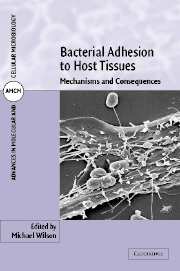Book contents
- Frontmatter
- Contents
- List of contributors
- Preface
- Part I Bacterial adhesins and adhesive structures
- 1 Surface protein adhesins of staphylococci
- 2 Mechanisms of utilization of host signalling molecules by respiratory mucosal pathogens
- 3 Adhesive surface structures of oral streptococci
- 4 Regulation and function of phase variation in Escherichia coli
- 5 Regulation of capsule expression
- 6 Role of pili in Haemophilus influenzae adherence, colonization and disease
- Part II Effect of adhesion on bacterial structure and function
- Part III Consequences of bacterial adhesion for the host
- Index
- Plate section
1 - Surface protein adhesins of staphylococci
Published online by Cambridge University Press: 08 October 2009
- Frontmatter
- Contents
- List of contributors
- Preface
- Part I Bacterial adhesins and adhesive structures
- 1 Surface protein adhesins of staphylococci
- 2 Mechanisms of utilization of host signalling molecules by respiratory mucosal pathogens
- 3 Adhesive surface structures of oral streptococci
- 4 Regulation and function of phase variation in Escherichia coli
- 5 Regulation of capsule expression
- 6 Role of pili in Haemophilus influenzae adherence, colonization and disease
- Part II Effect of adhesion on bacterial structure and function
- Part III Consequences of bacterial adhesion for the host
- Index
- Plate section
Summary
INTRODUCTION
Staphylococcus aureus is primarily an extracellular pathogen. In order to initiate infection it adheres to components of the host extracellular matrix (ECM). Adherence is mediated by surface protein adhesins called MSCRAMMs (microbial surface components recognizing adhesive matrix molecules) (Patti et al., 1994a). In most cases the MSCRAMMs are covalently bound to peptidoglycan in the cell wall. However, there are several examples of MSCRAMMs that are non-covalently associated with the wall. Coagulasenegative staphylococci also express MSCRAMMs. This chapter will discuss the mechanisms of attachment of proteins to the cell wall and will review the properties of MSCRAMM proteins that have been characterized at the molecular level.
ANCHORING OF PROTEINS TO THE CELL WALL
Cell-wall-anchored proteins that are covalently bound to peptidoglycan are recognizable by a motif located at the C-terminus (Navarre and Schneewind, 1999). This comprises the sequence LPXTG (Leu-Pro-X-Thr-Gly) followed by hydrophobic residues that span the cytoplasmic membrane and by several positively charged residues. The positively charged residues are required to hold the protein transiently in the membrane during secretion through the Sec secretome (Schneewind et al., 1993). The LPXTG sequence is recognized by an enzyme called sortase that cleaves LPXTG between the Thr and Gly residues (Navarre and Schneewind, 1994; Ton-That et al., 1999). The carboxyl group of the Thr is joined to the amino group of the branch peptide in nascent peptidoglycan. In the case of S. aureus, linkage occurs to the NH2 group of the fifth Gly residue of the branch peptide, which would otherwise form the interpeptide bridge of cross-linked peptidoglycan (Ton-That and Schneewind, 1999; Ton-That et al., 1999).
- Type
- Chapter
- Information
- Bacterial Adhesion to Host TissuesMechanisms and Consequences, pp. 3 - 26Publisher: Cambridge University PressPrint publication year: 2002
- 1
- Cited by

